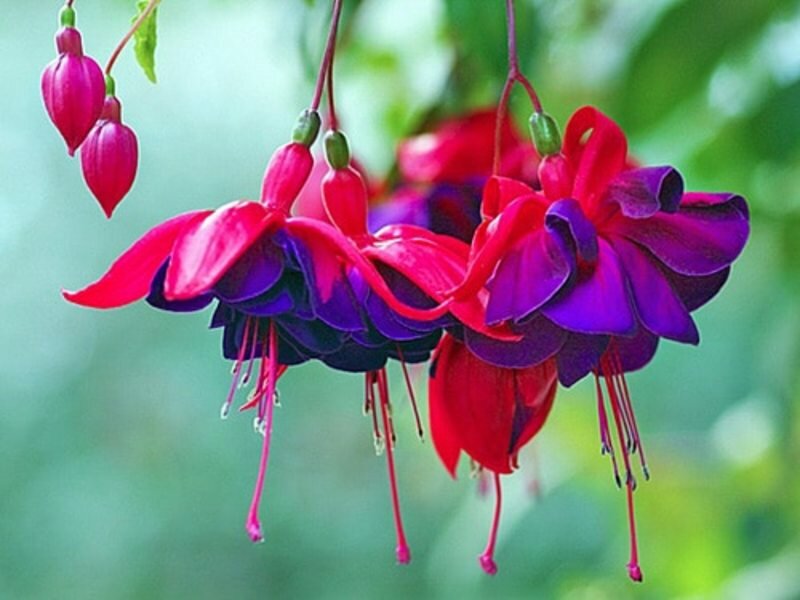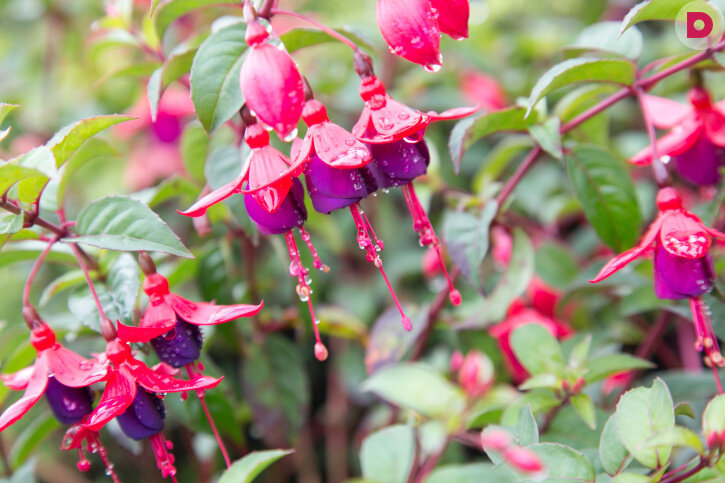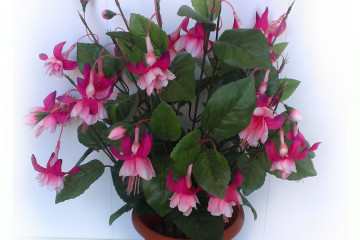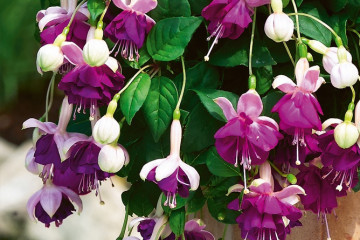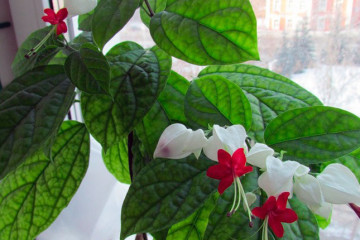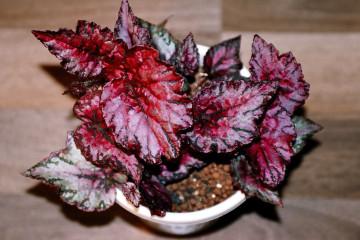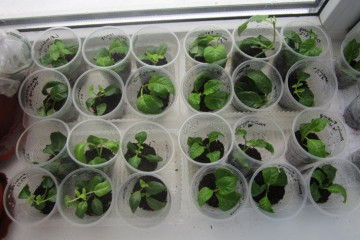Forming fuchsia at home and pruning
Content:
Fuchsia is a bright plant with a lush beautiful crown, quite unpretentious. It is for these qualities that it fell in love with flower growers. It is grown by both experienced flower lovers and beginners. Many people think that fuchsia is an exclusively house plant, but this is not the case. In regions with milder and warmer climates, it is very popular as an outdoor plant, the bushes of which reach a height of 1 m.
Formation of fuchsia at home
The main feature of the plant is its flowers. They combine several shades at once and have a very unusual shape. During the flowering period, several thinner stems are formed on each branch, on each of them, in turn, 3-4 inflorescences are formed, due to which fuchsia looks fantastic during the flowering period.
How fuchsia grows
How fuchsia grows is a question that many novice flower growers ask themselves. And this point is really very important, because it depends on how to form fuchsia at home. There are several types of flowers, depending on the direction of growth of the bush:
- ampelous. Very showy plants, suitable for growing on balconies and summer verandas. Since their stems are very long and flexible, they bend downward under the weight of their leaves and flowers. Hanging pots are needed to grow them;
- semi-ampelous. This type can be grown both as ampelous and as standing. It all depends on the desire of the grower. To get a straight bush, you just need to tie the main stems of the plant to a standing support;
- bush. Fuchsia shoots of this type stretch exclusively upward, even without additional support.
Do I need to pinch fuchsia
The formation of fuchsia at home is a rather fascinating and interesting process, since the crown of a plant can be given almost any shape. There is only one way to do this - by pinching. And this process is mandatory, because it is thanks to it that additional lateral shoots are formed with buds located on them, which, as a result, bloom. This simple procedure helps the plant to bush even more and acquire more lush flowering stems.
If it became noticeable that the plant was crushed, additional shoots did not appear on it, pinching of fuchsia must be done. Due to the procedure, the flower will revive, it will have more incentive to grow, and after a short period of time a much larger number of buds will appear on it than it was before.
How to pinch fuchsia at home
To carry out the procedure, one of two main methods is usually chosen. The classic version of pinching fuchsia:
- with each procedure, the growth point is removed from the flower, this contributes to the fact that the size of the plant doubles, and with it the number of flowers;
- for the first time, for fuchsia, the cultivation of which begins from a cutting, it is necessary to carry out three pinching procedures. It would be enough;
- the formation of the crown of fuchsia may take time - 2-3 months;
- flowering will occur after the establishment of a long daylight hours in the apartment, not earlier than 2 months after the last pinching procedure.
The second option for pinching fuchsia at home is K. Dave's method. It is based on the property of the plant itself to double the number of new shoots without new internodes. With its help, a lush plant is formed in a relatively short time. Since the number of growing shoots is large enough, it should be used with caution, there is a risk that the stems will break under the weight of the flowers.
The plant can be pinched at any time of the year, it is especially important to do this in winter to avoid pulling the stems out during the rest period. If you figure out how to pinch fuchsia, everything will work out.
Crown formation
To form the crown of a standard tree, the easiest way is to use upright varieties. In the first step, it is recommended to tie them to a solid base until the shoots are more resistant. You can also use ampelous varieties, the effect will be amazing, but this will take more effort. The main stem must be tied to the peg in several places. Once the plant reaches the desired length, the growth point must be pinched to form side shoots. This is how the crown will form. After completing this process, you can remove the support peg.
The formation of ampelous fuchsia consists in the removal of growth points for the formation of new lateral shoots. Initially, you need to let the main stem grow to the desired length, and then start pinching.
Fuchsia pruning
Most often, already in the middle of autumn, due to the reduction in daylight hours, fuchsia sheds not only flowers, but also leaves. This suggests that she needs peace. At this time, it is best to send it to a cool room with a temperature of about 10 ° C. Another option is also possible - wintering in a bright, humid room with a temperature of about 18 ° C. And after the end of the dormant period (late winter - early spring), fuchsia is pruned.
The extent and extent of trimming depends on the type of fuchsia. Upright, stacked forms require more time, but after correctly pruning they look more impressive than ampelous ones. If this stage of flower development is allowed to flow, then in the summer the shape will change, long, thinner and elongated stems will grow.
How to prune fuchsia in spring
First of all, you need to carefully examine the plant and remove all dry, weak, elongated, growing in the wrong direction, shoots. Next, you need to cut off strong branches by about half the length, to form the desired crown shape. You can cut the branches more strongly, leaving only 2-3 axillary buds. On the contrary, you can trim only 1/3 of the length.
What kind of land does fuchsia love?
The land for fuchsia needs fertile, it should contain a large amount of humus. It must also retain water well, since the soil must not be allowed to dry out, it must be constantly moistened.
What soil is needed
The easiest option is a slightly acidic soil for flowering plants, which can be easily purchased at any flower or horticultural store. If you have the time and desire, then you can prepare a mixture for planting and growing yourself.
There are several options:
- two parts of peat, three parts of deciduous land, one part of sand;
- two parts of greenhouse land, three parts of clay-grain land, one part of sand. A small amount of peat crumb will be an excellent addition to this combination;
- an equal combination of the following components: humus, peat, sand, leaf and sod land.
All of these options will give the required low level of acidity, close to neutral, level of friability. They will not allow water to stagnate, but they will also prevent a lack of it (with proper watering).
Planting and caring for fuchsia
Initially, fuchsia does not need to be planted in a large pot, the optimal diameter for planting a cutting is 10 cm.Only after the plant is fully hardened, its roots are completely entwined with an earthen ball, it can be transplanted into a larger pot. It is best to carry out this process simultaneously with pruning in February-March. The fuchsia pot must be completely filled with earth, which in no case should be tamped down with your hands. You just need to carefully monitor its amount.
Taking care of fuchsia is not difficult, the main thing is not to forget about some of the main factors:
- temperature. In summer, the most optimal temperature will be no higher than 25 ° С, but also not lower than 18 ° С. If the plant has to go beyond this framework for a long period, then it will quickly lose its decorative effect: the flowers will become smaller or completely fall off;
- location. The best option would be the east and west sides. Thanks to this arrangement, the plant will not be affected by direct sunlight;
- watering. It is much more important for the plant than fertilizing. It should be done regularly as the topsoil dries up, but it should not be drained too abundantly. It is impossible for the water to stagnate in the pan. In summer, the interval between watering should be no more than three days, in autumn - 1-2 times a week, in winter - once a month.
Fuchsia in the house is beautiful. No wonder she is often called a ballerina and even a flower of elves. It is simple and easy to care for and reproduce, does not require any special costs: neither financial nor time. A few simple rules should be followed, and she will thank the owner with a lush and bright flowering.

